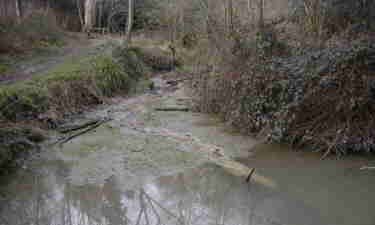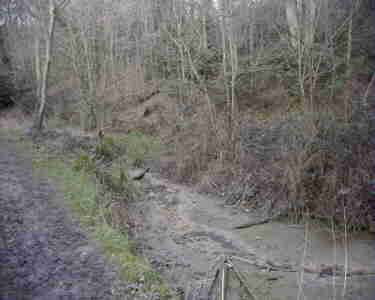![]() Home
Home
![]() History and historic pictures
History and historic pictures
![]() Municipal Vandalism
Municipal Vandalism
![]() Message to our Town
Councillors
Message to our Town
Councillors
![]() Ice House
Ice House
![]() Roman Bath
Roman Bath
![]() Victorian Walled Garden (Bohemia Walled Garden)
Victorian Walled Garden (Bohemia Walled Garden)
![]() Summerfields Woods
Summerfields Woods
Name:
No. 29 - Summerfields Woods
GR:
TQ809097
Area:
7.3ha
Habitat:
Semi-natural Woodland
Introduction:
Summerfields Woods occupies a central position within the Borough, being close to the seafront and town centre. A semi-natural woodland, it is well used by local residents from the numerous access points around the wood. A stream runs through the majority of the wood with two ornamental ponds at the southern end.
Stretching from Holmesdale Gardens in the south to the cricket pitch at Horntye in the north, the woods represent an important habitat for badgers and migjrating birds as well as a major woodland amenity in the middle of town. The majority of the woods are owned by Hastings Borough Council.
Site Notes :
There is an extensive path network running through the site, some of which have been improved during the late 1980's. Unfortunately there would appear to have been little upkeep of the paths and the majority have become neglected.
The main path into the site from Holmesdale Gardens in the south is the start of the Right of Way of Briscoe's Walk. This forms part of the Hastings Greenway Project which has, attracted Single Regeneration Bid monies to upgrade this path as part of a more extensive walkway, and improve the access to the woods .
The main woodland itself is not subject to any overall management plan and appears in a general state of neglect. The southern part of the wood is dominated by mature and regenerating sycamore with an understorey of holly and occasional ash and elder, with a ground flora of bramble, enchanters nightshade and ivy. Where the woodland opens out, there are very dense thickets of bramble. Ferns, red campion, wood avens, cuckoo pint, dog-violet and hemp agrimony are noted on the woodland floor. Cherry laurel and rhododendron are both found in the lower pa~ of the wood.

Two ponds form a predominant landscape feature of the lower part of the wood. It is thought the ponds, as well as other features within the woods, were constructed during the Victorian era. The ponds are in a very poor and neglected condition, under a dense canopy of overhanging trees, and possess poor marginal vegetation. Both water features suffer from silting, rubbish dumping and general neglect. The upper pond has an island feature which is now dominated by bramble and supports semi-mature birch trees. There. is limited marginal vegetation although clumps of Himalayan balsam, hogweed, flag iris, pendulous sedge and various ferns are growing at the waters edge. The entire surface of the top pond is covered in lemmna species
Some selective management is evident in an area east of the Sports Centre where native trees have been encouraged through selective thinning. This area was probably the most severely damaged after the storms of 1987. The ground flora here is a carpet of bluebells and bramble has been consistently cut back..
The stream which feeds the ponds runs down the central part of the woods wheren the bank sides are steep and densely vegetated with ferns, regenerating ash, holly and sycamore, bramble and rhododendron. The canopy is a mix of beech, sycamore, birch and rowan. A further small pond is located further north, in the middle of the woods, which provides the source of the stream from local land drains converging into one area.
A Victorian grotto is situated in one of the banks which has a flourishing population of liverworts around the dripping water from the surrounding bank.
The northern part of the wood supports a greater diversity of tree species with holm oak, willow spp., ash, oak, sweet chestnut, birch and beech although the woodland floor is still dominated by a matrix of ivy, nettle and bramble clumps.
The
development of the cricket pitch area to include an all weather hockey pitch has
affected the very top part of the woods which are owned by the Trustees of the
cricket club.
One of the most notable aspects of Summerfields Woods is they play host to one of the largest populations of badgers in the middle of town, with setts located throughout the woods and in adjacent areas
Discussion:
It is clear the woods represent a major wildlife and natural amenity asset in the town. They form an important habitat for migratory birds and nesting indigenous birds, as well as playing host to a large and thriving badger population. The fact there is de-facto access to the woods and there is an extensive, if somewhat neglected, path network encourages local residents to use the site as a walking area and through route to other areas of the town.
The woods represent an important habitat for migrant birds such as meadow pipit, redstart, whinchat, stonechat, wheatear and siskin as well as a breeding and feeding site for a host of more common birds such as greenfinch, chaffinch, jay, various tits and woodpeckers.
Whilst the existing path network is extensive throughout the woods it is difficult to stray from the paths due to the density of vegetation and the bramble/nettle clumps in particular.
There does not appear to be any formal management plan for the upkeep of the woods and their features. This is certainly an issue which requires urgent redress to bring the woods into a maintained, safe and cared for standard. As the woods have became the focus of much attention through the development of the hockey pitch, it will be essential to facilitate a management regime to encourage safe access for visitors and members of the local community, and to enhance the woods as a wildlife haven in the town.
SNCIís: April 1998 pp59/60
010706 040924 050122 050904 070618 080719 081017 091229 100116